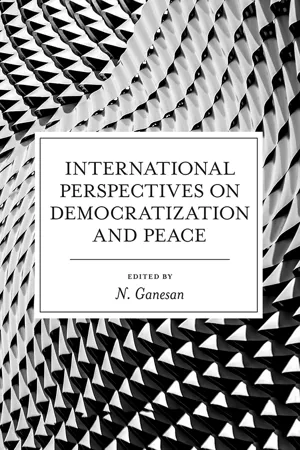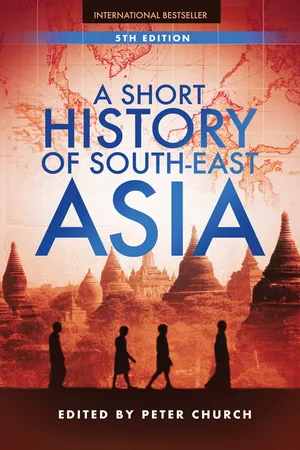History
Cambodian Civil War
The Cambodian Civil War was a conflict that took place from 1967 to 1975 between the government of Cambodia and the communist Khmer Rouge forces. The war resulted in widespread devastation and loss of life, and ultimately led to the rise of the Khmer Rouge regime, which imposed a brutal and repressive rule over Cambodia.
Written by Perlego with AI-assistance
Related key terms
2 Key excerpts on "Cambodian Civil War"
- Narayanan Ganesan(Author)
- 2020(Publication Date)
- Emerald Publishing Limited(Publisher)
The development of Cambodian modern history has been unstable, it was filled with violence, civil wars, mass killings and intervention from foreign countries. Since the nineteenth century, Cambodia was a French colony and became a part of French Indochina that also included present day Vietnam and Laos. During World War II, the Japanese army occupied Cambodia and the country came under the double domination of both Japan and France. In 1945, Cambodia declared its independence from France, which was however rejected. In 1953, Cambodia once more declared its independence and this time around it became an independent country. The independence of Cambodia and Laos in 1953 foreshadowed the French military defeat in Vietnam in 1954 that led in turn to Vietnam being divided into two halves with the north becoming Communist and the south being controlled by a military authoritarian government. The dynamics of the Cold War was played out in Indochina through proxy wars that pitted the West led by the United States and the Communists who were supported by China that had already become Communist in 1949.From the time of its independence, Cambodia has experienced many political regime types: the Kingdom of Cambodia from 1953 to 1970 (Sangkum Reastr Niyum era or Sihanouk era), the Khmer Republic from 1970 to 1975 (Lon Nol regime), Democratic Kampuchea from 1975 to 1979 (Pol Pot regime), Peoples’ Republic of Kampuchea from 1979 to 1992, the Kingdom of Cambodia with two co-prime ministers system from 1993 to 1997 as part of a national reconciliation process following international intervention, and the government of the Cambodian People’s Party since 1998 (Sasagawa, 2018 ).The Cambodian Civil War was a long-drawn conflict that lasted more than 20 years from 1973 to 1997. It reflected Cold War dynamics and highlighted the complicated relationships between several parties and politicians. As a small and dependent country, its elite was unable to control the country and its population. And in the face of intervention in the country’s domestic politics by larger external powers, the situation became complex and prone to violence. Leading elites sought to buttress their political legitimacy and support through external guarantors that were only too eager to become involved in providing such support as part of a broader regional and global strategy.- eBook - ePub
- Peter Church(Author)
- 2012(Publication Date)
- Wiley(Publisher)
Chapter 2 CambodiaNo country in South-East Asia has a more imposing early history than Cambodia. The temples of Angkor, erected between the 9th and 13th centuries, are a testament to the creative energy, wealth and power of Khmer society in that era. But no country in the region has had a more tragic recent history. Ravaged by war and revolution in the 1970s, a decade in which more than one in seven Cambodians died, Cambodia remained a victim of international Cold War rivalries in the 1980s. It is only now, following the turn of the century, that peace and a semblance of economic security is re-emerging in Cambodia.One striking theme in Cambodia's history is the country's almost-continuous entrapment in the rivalries of outside forces. Until the 19th century, these forces were regional. Since then, Cambodia has been tossed and tormented by world forces, to a degree that sometimes seems inexplicable given Cambodia's small population and poverty. Cambodia's population was assessed at 14.5 million in 2008. Its GDP per capita was US$540.Another striking historical theme, intertwined with the first, concerns the perennial struggles for power within Cambodia at the expense of the country's general well-being. Traditionally, in a matter of ruling class rivalries, the power struggles have been grotesquely magnified by this century's global ideological collisions.Cambodia has known peace, sometimes for extended periods, but always under rulers who enforced peace. French colonial rule achieved a kind of peace in Cambodia, as did King Sihanouk in the 1950s and 1960s. Today the Cambodian government works hard to maintain social cohesion while promoting economic growth now that peace seems to have finally come to the country.Early history and the empire of AngkorThe first glimpses into Cambodian history come from the early centuries of the Christian era. By then Khmers—direct ancestors of Cambodia's modern population—and related Mon peoples occupied a broad band of mainland South-East Asia, stretching across what is today southern Burma, Thailand, Cambodia and southern Vietnam. Early Chinese records mention trade with a society on the lower Mekong which they term “Funan” (perhaps a transcription of the Khmer word phnom
Learn about this page
Index pages curate the most relevant extracts from our library of academic textbooks. They’ve been created using an in-house natural language model (NLM), each adding context and meaning to key research topics.

